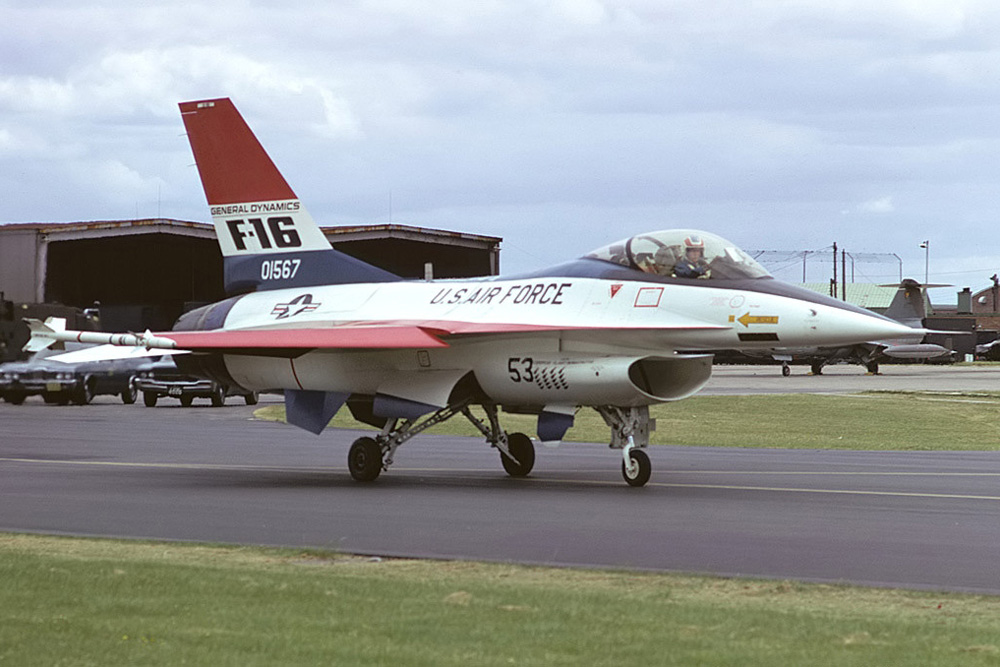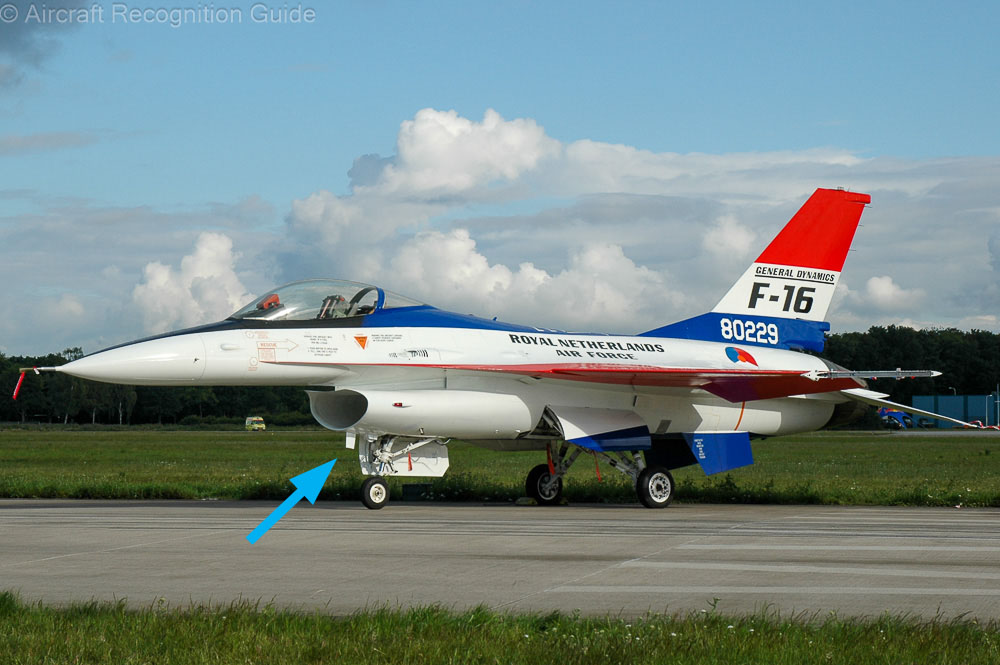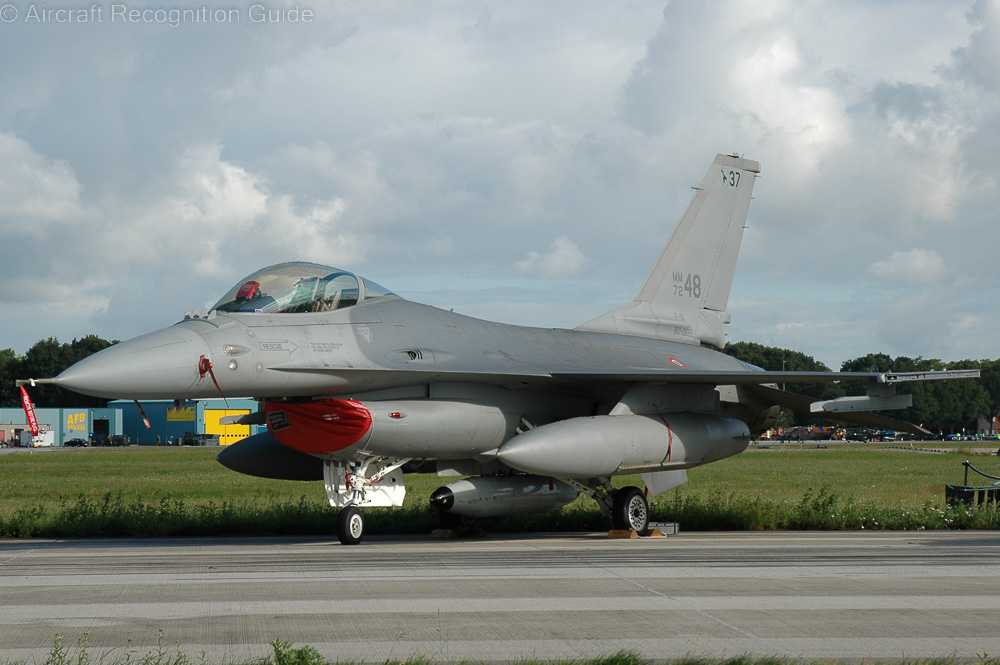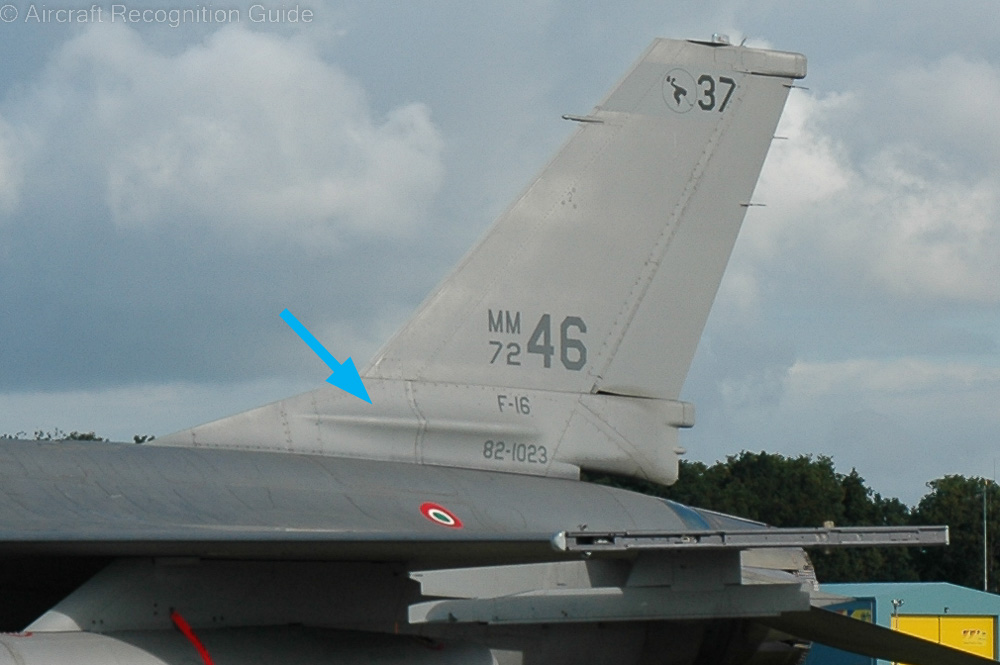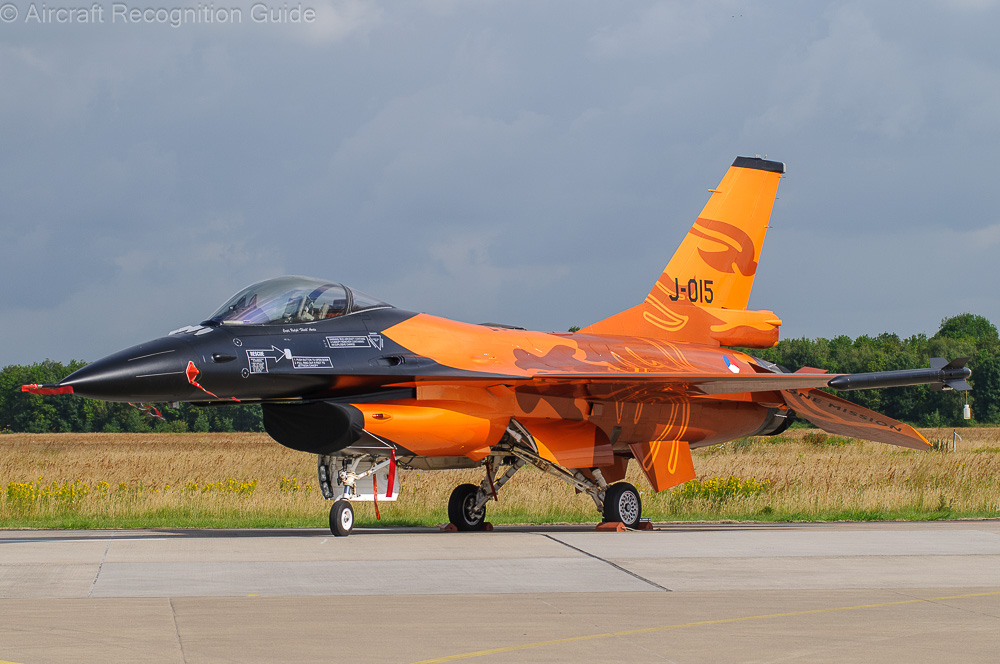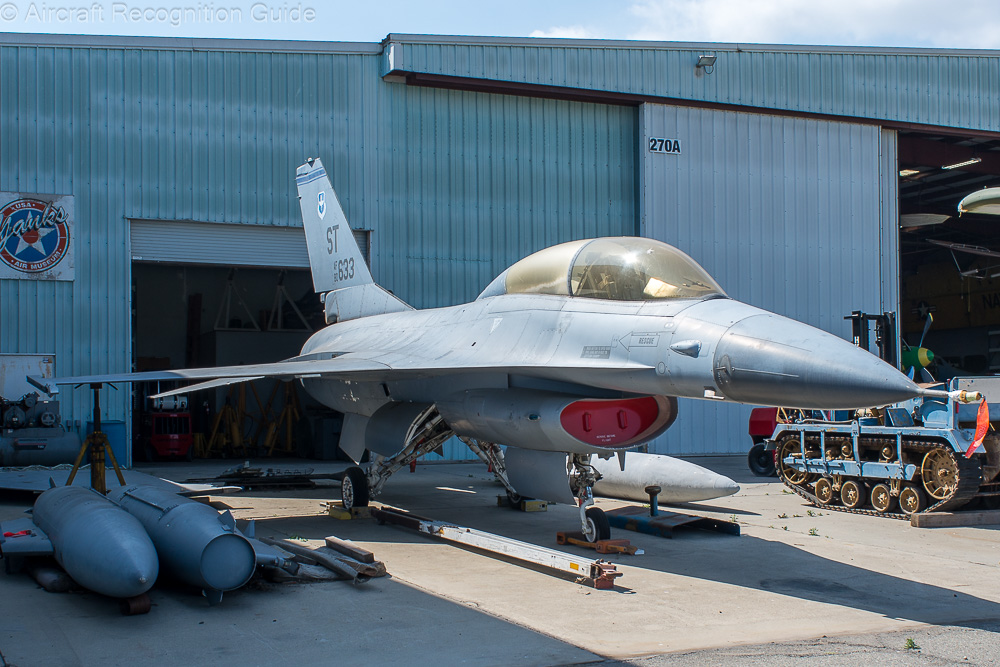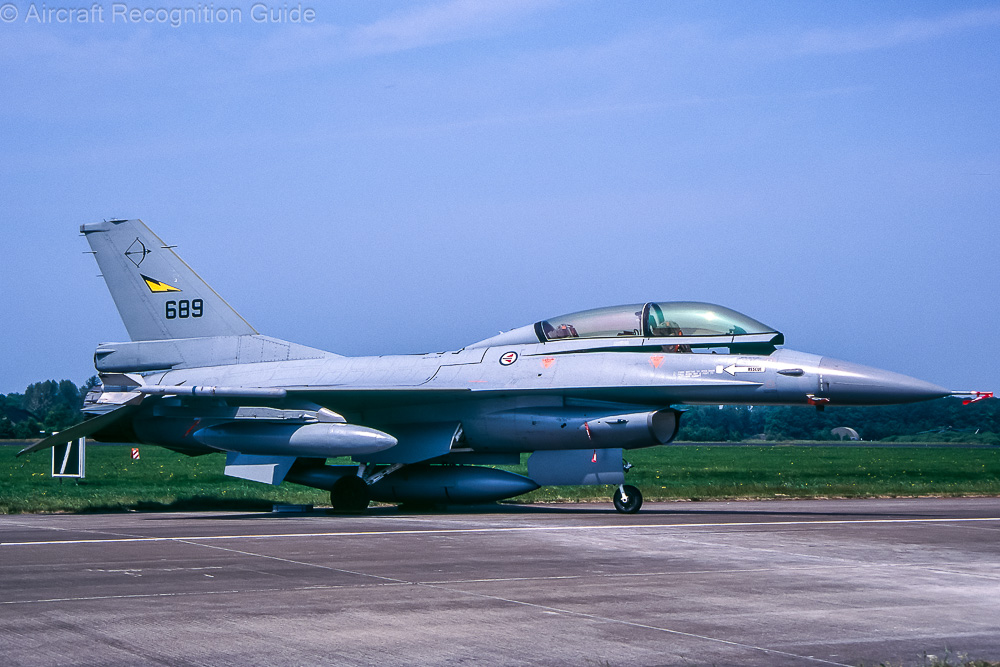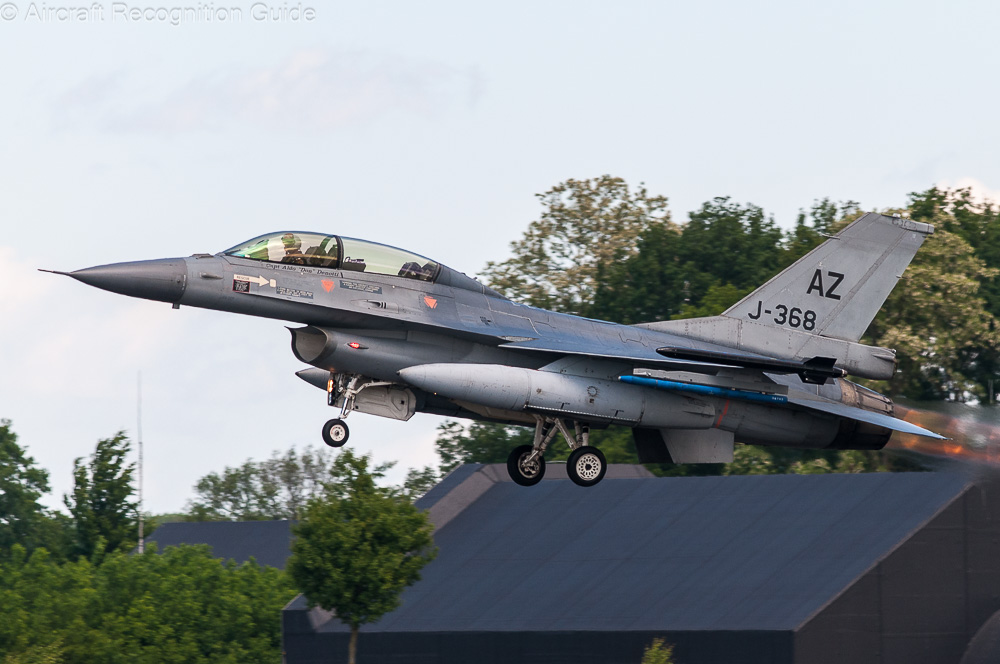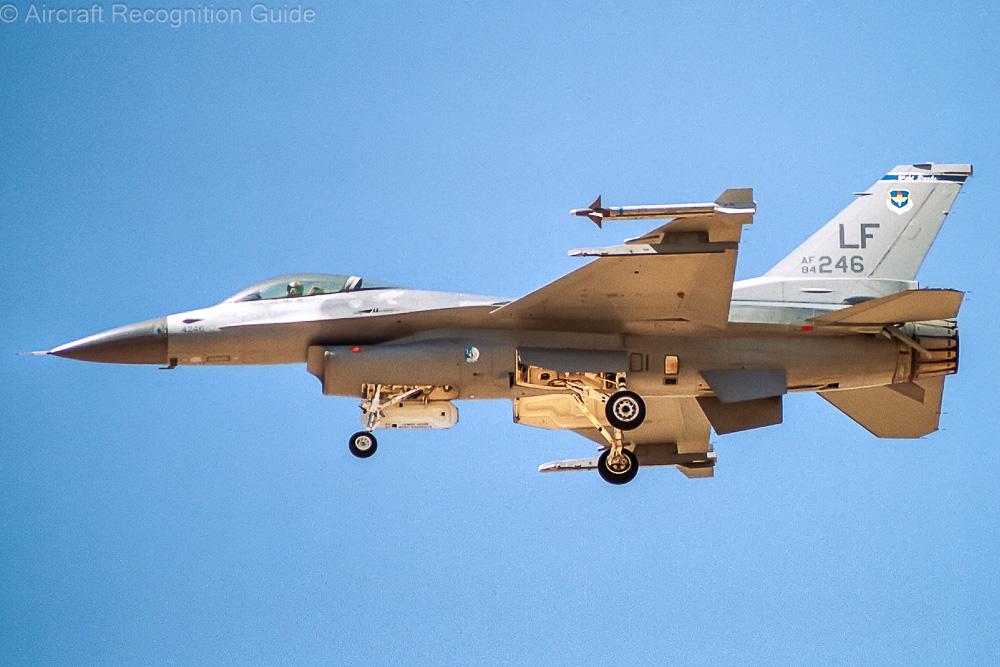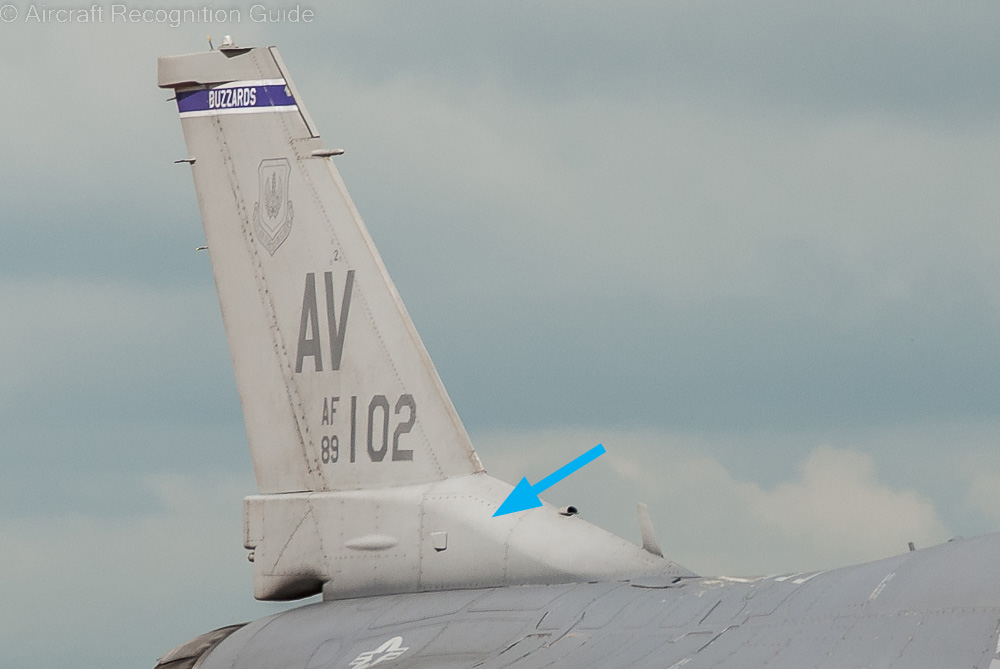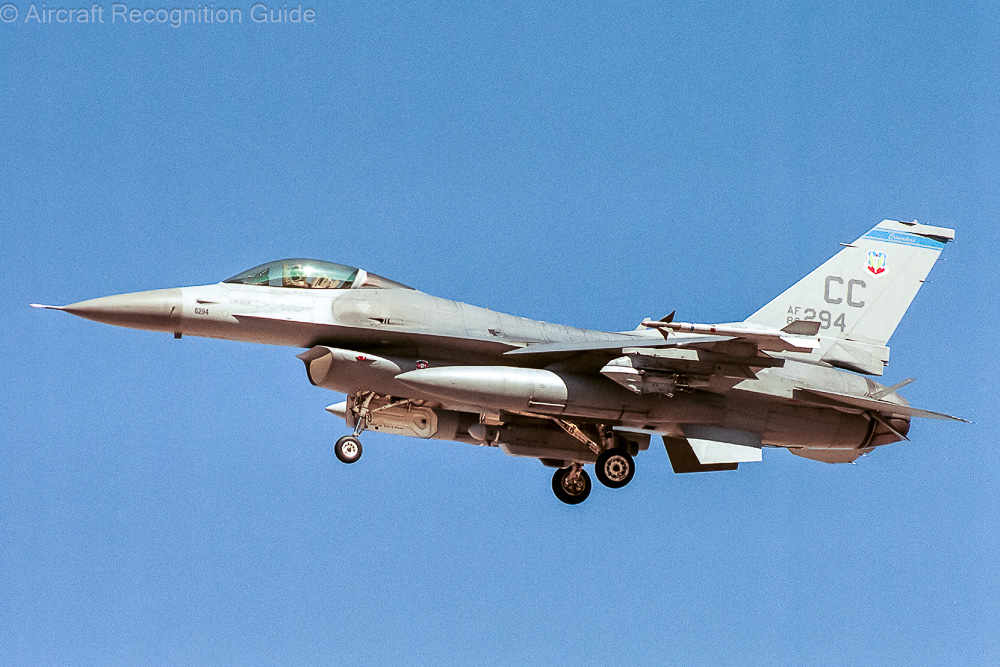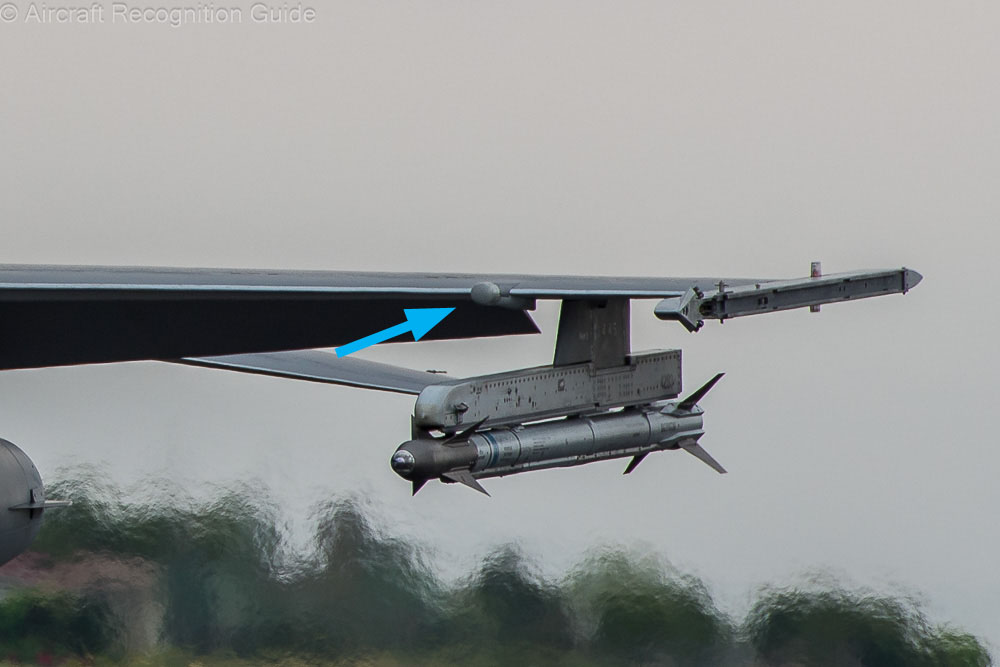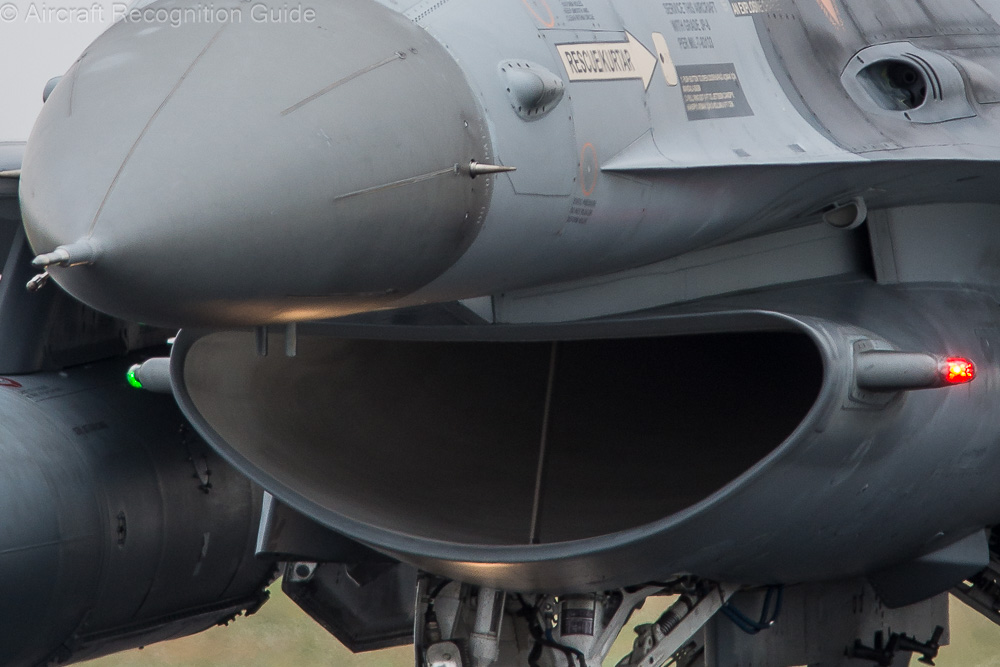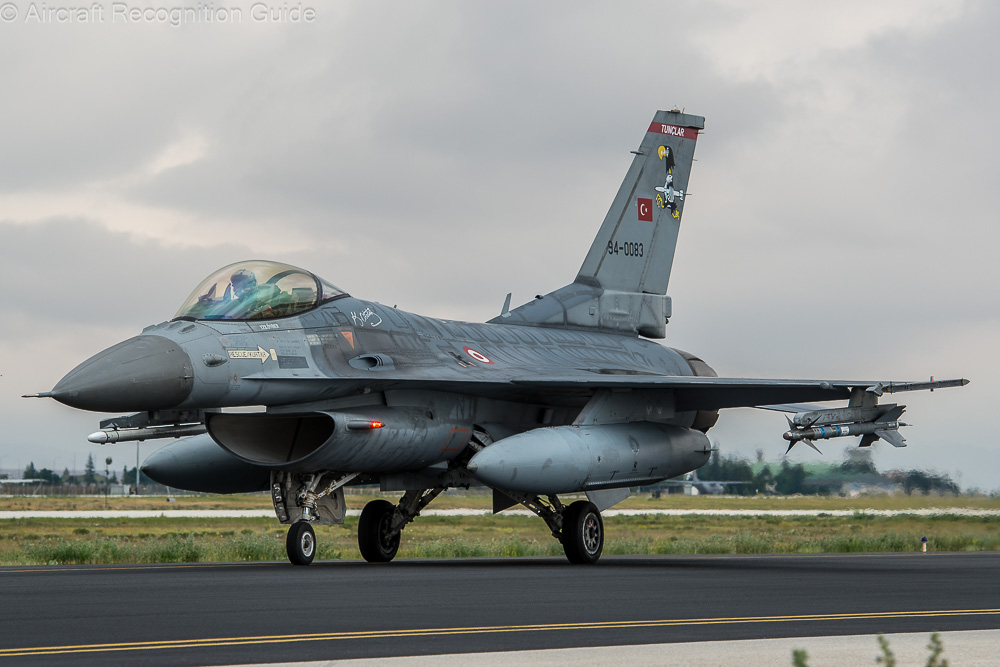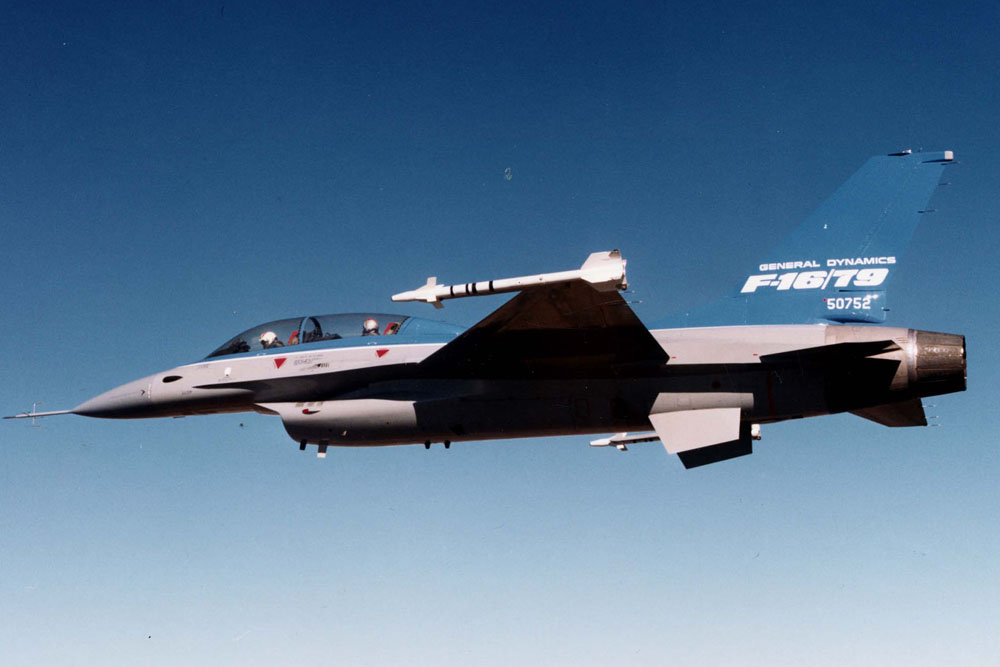
Lockheed Martin (General Dynamics) F-16 Fighting Falcon
The F-16 is one of the most common single engine fighters since the 1970s, so you are likely to encounter one. Its shape is quite unique, although it was nearly copied on the Mitsubishi F‑2! The typical aspects of the F‑16's shape are the two-piece bubble canopy, the "smiling mouth" shaped air intake under the forward fuselage, and the cropped delta wings blending smoothly into the fuselage, with leading edge extensions (strakes) until below the canopy. While officially called Fighting Falcon, it is also known by the nickname Viper.
Different versions
The number of different detailed versions of the F-16 is numerous and often they are not easy to distinguish. It doesn't help that even within major variants (Block versions) there are a lot of options with regard to sensors, weapon systems, etc. that may not be present on all aircraft of the same Block upgrade. Below the main Block versions of the F-16 are described and they can be recognised by looking at:
- the shape of the base of the vertical stabiliser
- the presence, number and and shape of antennas in front of the canopy
- the presence of a cannon at the junction of the left leading edge wing extension and fuselage
- the diameter of the nose
- the presence and size of the horizontal stabilisers
- the number and shape of antennas in front of the nose gear
- the shape of the wings
- the shape of a ram air intake between the fuselage and air intake itself
- the location of the landing lights
- the presence of a long spine on top of the fuselage
- the presence of conformal fuel tanks at the upper sides of the fuselage
- the shape of the head-up dusplay (HUD)
- the type of sensor pods below the air intake
YF-16
The F-16 was the winner of a competition between the YF-16 and YF-17, although the YF-17 was eventually developed in the successful F/A-18 Hornet. The YF-16 already looks a lot like the production version. The YF-16 is slightly shorter though. However, it is easier recognised by the smaller diameter nose.
The YF-16 prototype has a sharper nose than the F-16A and subsequent versions. (photo: Mike Freer - Touchdown-aviation/WikiMedia)
F-16A (Block 1 & 5)
The first production version had a bigger radar and to accommodate that the diameter of the nose cone was increased. The Block 1 version can be distinguished from later versions by the black nose, smaller horizontal stabilisers and single rectangular antenna below the air intake, in front of the nose gear. Block 5 is externally the same except for a grey (or actually non-black) nose.
Common to all F-16A versions is the base of the vertical fin, including the dorsal fin, that gradually becomes wider from front to rear.
The first F-16 production versions, up to Block 10, have a blade antenna in front of the nose gear. On this F-16A Block 5 it is rectangular (see blue arrow). Compare it to the Block 10's antenna below!
The small horizontal stabilisers of the F-16 up to Block 10 have no cut-off rear corner as easy recognition point.
Nearly all versions of the F-16 have this type of head-up display (HUD): straight sides with a curved, non-framed top.
Common to all F-16A and -B versions is the gradually widening base of the vertical stabiliser, from the dorsal fin to the back. Note the extension beyond the rudder, which houses the optional drag chute.
All F-16A/Bs and some F-16C/Ds are powered by a Pratt & Whitney engine, that is characterised by narrow, straight petel plates.
F-16A (Block 10)
Just the shape of the blade antenna in front of the nose gear is different in the Block 10 variant. This has a triangular shape instead of a rectangular one.
In Israel F-16A/Bs of Blocks 1, 5 and 10, that were modified to be equipped with Israeli systems, are called Netz.
The blade antenna of the Block 10 F-16A, in front of the nose gear, is triangular.
F-16A (Block 15)
The Block 15 variant can store weapons under the air intake, on the left and right side of the nose gear. To manage the changed weight distribution, the horizontal stabiliser are 30% larger than the earlier block versions. They are more easily recognised by the cut-off corners between the tip and the trailing edge. Finally, the blade antenna in front of the nose gear is gone.
F-16A ADF (Block 15)
The special Air Defense Fighter (ADF) variant has no dedicated block number, but all are upgrades of Block 15s. The ADF has long, narrow bulges at the side of the base of the vertical stabilisers. Moreover, it has two sets of four blade antennas, one set in front of the canopy and one in front of the nose gear. They have a cut-off triangle shape, different from the MLU antennas. Finally, the F-16A ADF has a search light on the left side of the nose.
The four antennas in front of the nose of the F-16A ADF have a different shape than those of the F-16AM. Note the search light at the side of the nose.
F-16AM (block 20)
To bring the existing F-16As closer in capabilities as the F-16C a major modification programme let to the Block 20, often designated F-16AM. The M is this case stands for Mid-Life Update (MLU). Many changes are on the inside, but on the outside the four long blade antennas in front of the canopy are the main recognition point. These are also found on the Block 40 and later, after receiving the CCIP. Additionally, the MLU version has two landing lights attached to the nose gear door. Compared to Block 1/5/10 aircraft they can also be equipped with pylons at the side (chin) of the air intake.
F-16B (Block 1, 5, 10 & 15)
The two seat version of the F-16 is the F-16B. Except for a tandem canopy it is the same as the F-16A. It also has the same differences in the Block versions. Even the F-16B ADF is externally identical to the Block 15.
F-16BM (Block 20)
The Mid-Life Update (MLU) version of the F-16B is called F-16BM, and is the Block 20 version. It can be distinguished from earlier block versions by the four long, narrow blade antennas in front of the canopy.
Even from a distance you can see the F-16BM's typical four blade antennas in front of the canopy.
F-16C (Block 25)
While on the inside the Block 25 is significantly different from the Block 15 model, perhaps therefore warranting the new F-16C designation, externally these versions are almost the same. The main difference is in the shape of the base of the vertical stabiliser. This is immediately wide from the dorsal fin at the front instead of gradually widening on the A model. In front of the vertical fin is a small blade antenna.
The first F-16C version was a Block 25 F-16. It still has the Pratt & Whitney engine with narrow petal plates in the nozzle. This particular example has been upgraded with the RWR of the Block 30 in the wings.
On this detail of the tail you can clearly see where the base of the vertical stabiliser becomes wider, the key feature of the F-16C compared to the F-16A.
F-16C (Block 30)
All F-16s had so far been equipped with a Pratt & Whitney engine. However, the Block 30 F-16C has a General Electric engine. This requires more air, so the air intake has been increased in size, although this was not done from the start. At first a single type of intake was to be used, hence the name MCID or Modular Common Intake Duct, but in the end the P&W powered aircraft retained the smaller intake (referred to as NSI-Normal Shock Inlet). The large intakes can be distinguished from original smaller ones as the former have less rounded corner because the intake was widened. Additionally, the ECS ram air inlet duct below the fuselage and above the intake is canted slightly forward on the 'big mouth' F-16s. Finally, the engine exhaust nozzle for GE-powered aircraft is slightly shorter than that of the P&W-powered F-16s, and the GE exhaust has wider, curved petals.
Other changes on the Block 30 (and Block 32) were the radar warning receiver in the wing leading edges close to the wing tips, although these may have been retrofitted to earlier C models as well. Finally, the Block 30 has four instead of two chaff/flare dispensers on the left side of the fuselage.
The F-16C Block 30 was the first version with a General Electric engine. It has a different exhaust, a wider air intake and other features.
These 'bear can' radar warning receivers were first placed on Block 30 F-16s, but Block 25 received them later as well.
The ram air intake of the Environmental Control System (ECS) is canted forward on the GE powered aircraft with the wider air intake.
F-16C (Block 32)
This version is the same as the Block 30 F-16C, except that it retains a Pratt & Whitney engine. Therefore it has the same air intake and exhaust as the Block 25. The only external difference is the location of the radar warning receivers in the 'bear cans' in the wing leading edges. However, as nearly all Block 25 have received them after modification, there is no way to keep Block 25 and Block 32 F-16s apart.
Except for the colour scheme this Block 32 F-16C is not different from the Block 25 F-16C above.
F-16C (Block 40) & F-16CG
Apart from many upgrades to avionics and weapon systems, the F-16C Block 40 got a longer landing gear with larger diameter main wheels. To enable storage inside the fuselage, the main landing gear doors have a slight bulge, especially visible when the doors are open: the hinge has a bent. Additionally, the nose gear landing lights are now attached to the nose gear door, like on the MLU F-16A/B, instead of on the main gears. Otherwise the LANTIRN pod attached to a pylon at the lower side of the air intake would block the lights. This storage location is also a novelty for the Block 40. For the rest the Block 40 is externally the same as the Block 30, so with a wide intake and wide, curved nozzle petal plates.
All these modification would be sufficient for a new subtype (F-16G), but politically this was not desirable. Hence, the unofficial designation of the Block 40/42 F-16 is F-16CG, so still a variant of the F-16C.
After the Common Configuration Implementation Program (CCIP), to bring the Block 40/42/50/52 more in line with the F-16AMs, some Block 40 F-16Cs have the four typical narrow antennas in front of the canopy. However, most USAF F-16C Block 40s still lack them, so here you have a potential recognition point compared to the F-16CJ.
Block 40 F-16Cs delivered to Israel are locally called Barak. They have an extended base of the vertical stabiliser, like those with a drag parachute. However, they have no chute but likely more electronics. They also have diffferent systems, but are otherwise generally similar to other Block 40 F-16Cs.
The LANTIRN pod at the side of the air intake is clearly visible on the F-16C Block 40. Other features like the landings lights and main gear doors, are a bit hidden.
The main landing gear door of the Block 40 F-16 and subseqent versions has a curved hinge edge at the top. This is straight on earlier versions.
F-16C (Block 42) & F-16CG
Like the Block 32 is the Pratt & Whitney powered sibling of the Block 30, the Block 42 is the same of the Block 40. So look for the same characteristics as for the Block 40 but then with the narrower NSI air intake and long nozzles of the P&W engine.
This Thunderbird F-16C Block 42 has no chin mounted sensors, but the straight petal plates of the nozzle, curved main landing gear door are landing lights attached to the nose gear door are obvious.
F-16C (Block 50) & F-16CJ
On the Block 50 the General Electric lowered, 'big mouth' F-16C became even more advanced. Externally, there are no clear differences compared to the Block 40. The exception is the Wild Weasel subvariant, which has a sensor (HTS or HARM Targeting System) mounted at the left or right side of the air intake. In USAF service this specific version is unofficially called F-16CJ, for the same political reason as the F-16CG (Block 40) above.
After the Common Configuration Implementation Program (CCIP) to bring the Block 40/42/50/52 more in line with the F-16AMs, they also have the four narrow IFF antennas in front of the canopy, that are typical for the MLU F-16s. Because (many) USAF Block 40s did not get them, the presence of the 'bird cutter' antennas is a sign that you are dealing with a Block 50.
F-16C (Block 50+)
Later during the production run of the Block 50 Lockheed added the ability to attach conformal fuel tanks to the upper sides of the fuselage, thus creating Block 50+. These tanks are optional though, so you could see Block 50+ aircraft without. Furthermore, the Block 50+ has the CCIP features, including the four blade antennas on the nose.
With the conformal fuel tanks at the upper sides of the fuselage, available from F-16 Block 50+ on, the cross section becomes more square.
F-16C (Block 52)
When a Block 50 is equipped with a smaller intake, a Pratt & Whitney engines and long narrow petal plates in the exhaust, the version is designated Block 52.
In South Korea this version is locally designated as KF-16, but earlier Block versions don't seem the have one.
F-16C (Block 52+)
You guessed it of course: the Block 52+ is a Block 52 F-16 with the optional conformal fuel tanks at the upper side of the fuselage.
This top view of an F-16C Block 52+ clearly shows the shape of the conformal fuel tanks.
F-16D (Block 25, 30, 32, 40, 42, 50, 52), F-16DG & F-16DJ
All these Block variants have a dual seat version, designated F-16D, F-16DG or F-16DJ, depending on the Block number. The differences between the Block versions are the same as for the single seat F-16Cs. Compared to the F-16B the F-16D of course have the wider base of the vertical stabiliser.
The F-16D Block 40 of Israel, called Barak there, already have the dorsal spine that became standard on the Block 50+ and later versions. These two seat aircraft are not used for training; the rear seat is for the weapon systems operator.
As an illustration of the F-16D we show you a Turkish Block 40 F-16D that has gone though the CCIP update.
F-16D (Block 50+, 52+)
Block 50+ and Block 52+ F-16Ds are the two seater versions that have the capability of attaching conformal fuel tanks over the wing roots, although they not necessary have them all. Additionally, these F-16Ds often have a dorsal spine between the canopy and vertical fin, providing more storage for avionics.
F-16E (Block 60, 62)
Finally, with the introduction of the Block 60 and Block 62 F-16 a new subtype was being used, F-16E (although the E had previously been reserved for the production version of the F-16XL, see below). The E models' key feature compared to the Block 50+/52+ is the dorsal fin that has a slightly curved top, when viewed from the side. There is a small inlet on the right side and small outlet on the left side. Furthermore, the F-16E has a fixed FLIR sensor in the nose, in front of the four narrow blade antennas. Like on the Block 50+/52+ the conformal fuel tanks are optional.
The side view of this F-16E show you the curved top of the dorsal fin with intake at the side, and FLIR sensor on top of the nose. (photo: Konstantin von Wedelstaedt/WikiMedia)
F-16F (Block 60, 62)
Compared to the previous F-16D Block 50+ and Block 52+ the F-16F (Block 60 and Block 62) have a fixed FLIR sensor in the nose, in front of the four narrow blade antennas. Also, the long dorsal spine seems to be standard, as are the conformal fuel tanks. Finally, the additional left side outlet and right side inlet in the dorsal fin are present on the F-16F as well.
The F-16F is distinguished from the Block 50+/52+ by the FLIR sensor in the nose and inlet/outlet at the sides of the dorsal fin.
F-16I Sufa
Most F-16s of the Israeli air force are similar to the respective USAF versions. There is one exception, the F-16I Sufa. This version based on the F-16D Block 52+ has a lot of Israeli avionics and weapon systems. Externally, the most striking difference are the different sensors at the side of the nose, below the four IFF blade antennas.
The Israeli F-16I Sufa looks very similar to the F-16D Block 52+, but has different antennas at the side of the nose (photo: Israel Air Force/WikiMedia)
F-16N & TF-16N
The US Navy used modified F-16C/D Block 30 aircraft as adversary trainer. They are externally nearly the same as early Block 30 F-16Cs with the small air intake. At the right side of the intake a radar warning receiver is mounted, which is the only external recognition point. TF-16N is the designation for the dual seat model.
The F-16N was used as 'enemy' aircraft for training US Navy pilots. From the outside they are the same as the F-16C Block 30 except for the RWR at the right side of the air intake.
F-16V (Block 70 & 72)
Both available as upgrade and newly built aircraft, the F-16V (likely from the nickname Viper), is not easy to distinguish from earlier versions. At least, we have not yet been able to find one. But maybe that will come in time.
The F-16V has no clear recognition points.
F-16XL
General Dynamics developed this derivative of the F-16 as competitor to the F-15E Strike Eagle. Apart from being longer, hence the XL suffix, it has delta wings with a cranked arrow shape: there are two bends in the leading edge, and one in the trailing edge. These wings are similar to those of the Saab Draken. The horizontal stabilisers were removed, as were the ventral fins. The F-16XL-1, the first test aircraft, had the original, small air intake, while the second one (F-16XL-2) has the larger one, that was subsequently used on the Block 30/40/50/60 aircraft.
The large delta wings of the F-16XL are evident on this photo, as is the lack of horizontal stabilisers. (photo: WikiMedia)
F-16/79
To make the F-16 potentially more interesting for 'low budget' air forces, General Dynamics equipped the F-16 development aircraft with a J79 engine, that is also used on the F-4 Phantom II and F-104 Starfighter. It can be distinguished from the F-16A/B by the longer exhaust, extending well beyond the tail.
The longer exhaust of the J79 is the main recognition point of the F-16/79, here in the shape of an F-16B. (photo: WikiMedia)
F-16 AFTI/CCV
The YF-16 prototype and an early production version were used to develop the F-16 further. AFTI stands for Advanced Fighter Technology Integration. This version originally had canards below the air intake, that were first used on the YF-16 CCV (Control Configured Vehicle). Added were a bulge along the spine, on top of the fuselage, as an extension of the dorsal fin, that became standard on later block version. Furthermore, two sensors were placed on the nose, in front of the canopy, and a single one in each wing leading edge. Later, the canards were removed, as were the sensors in front of the canopy.
Here is the F-16 AFTI after it was retired. Still visible are the sensors in the wing's leading edge, and the bulge spine on top of the fuselage.
Confusion possible with
Mitsubishi F-2
The resemblance between the F‑16 and the Mitsubishi F‑2 is striking. They are nearly identical on the outside. This is due to an arrangement between the USA and Japan. When you look at the canopy of both aircraft you see that recognition is actually quite easy: the F-2 has a three-piece canopy, the F-16 a two-piece. The F-2 is also larger but that is less obvious.
IAI Lavi

The Lavi can be described as an F-16 with canards instead of conventional horizontal stabilisers. For the rest the resemblance is large, up to the oval shape of the air intake underneath the fuselage.
Chengdu J-10

The same can be said about the Chengdu J-10. This also has a delta wing-canard configuration and an air intake under the fuselage. However, it is not separated from the fuselage - like on the F‑16 - but directly placed underneath it. (photo Aktug Ates/WikiMedia)
Eurofighter Typhoon
While the Typhoon has the same basic configuration regarding the location of the air intake, canopy and wing shape, it is significantly bigger than the F-16. Also it has a rectangular air intake split in two, and canards instead of horizontal stabilisers.



